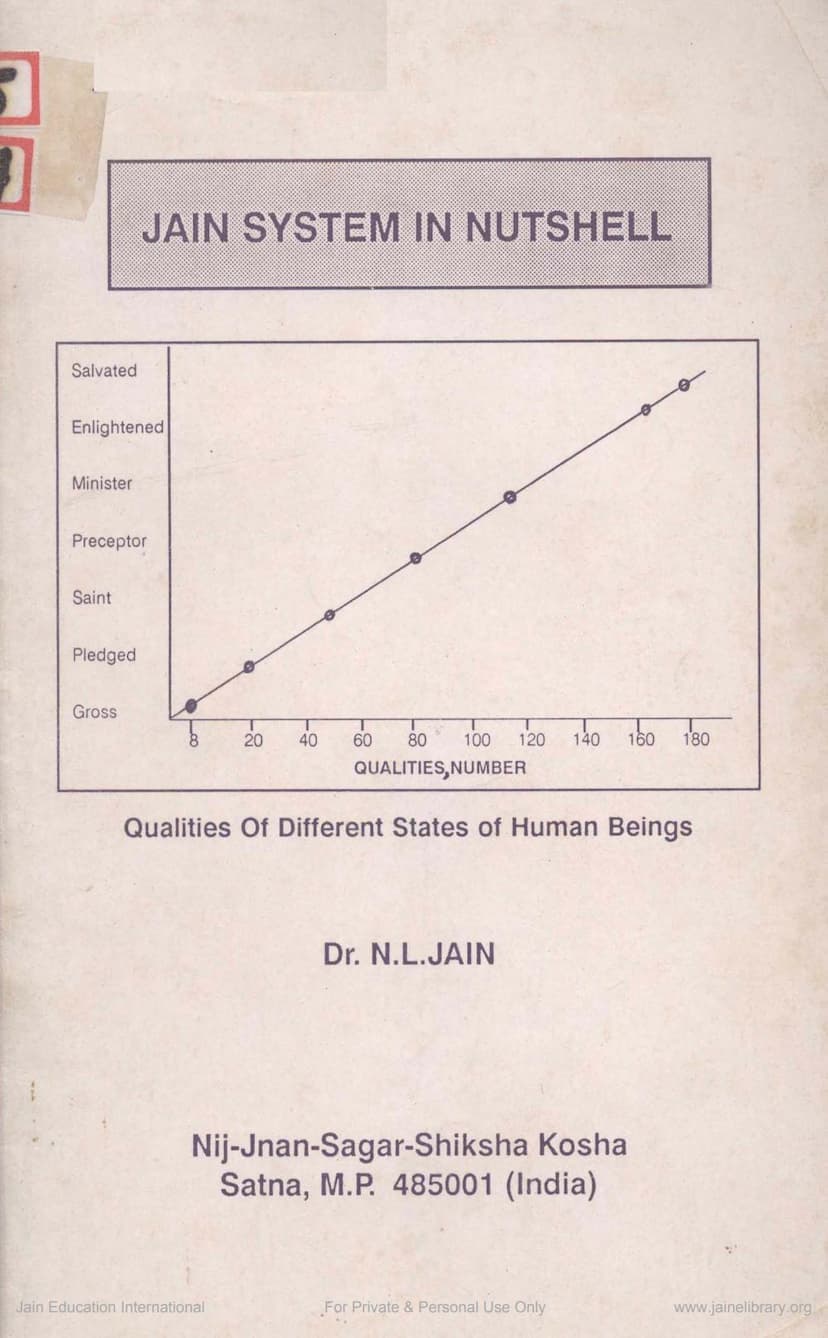Jain System In Nutshell
Added to library: September 2, 2025

Summary
Here's a comprehensive summary of the Jain text "Jain System in Nutshell" by N.L. Jain, based on the provided pages:
Overall Purpose and Approach:
"Jain System in Nutshell" aims to present the Jain philosophy and way of life in a concise, accessible, and scientific manner, particularly for a modern audience. The author emphasizes the logical, rational, and scientific underpinnings of Jainism, presenting it as a holistic science that can offer solutions to contemporary issues. The book seeks to bridge the gap between science and religion, showcasing Jainism's relevance in the modern world.
Key Themes and Concepts:
- Scientific Foundation: A central theme is the inherent scientific nature of Jainism. The author argues that Jainism's principles of observation, inference, reasoning, and non-dogmatism align with scientific methodology. It's presented not just as a religion but as a comprehensive science of the cosmos and human existence.
- Non-Violence (Ahimsa) as the Core Principle: Non-violence is presented as the paramount principle, permeating all aspects of Jainism, from personal conduct to ecological awareness. Its application is described as unconditional and a permanent solution to the world's violence. This extends to non-violence towards all living beings, including plants and microorganisms.
- Holistic Approach: Jainism is depicted as a holistic system encompassing ethics, spirituality, biology, botany, zoology, and ecology. It addresses the individual, society, and the cosmos in an integrated manner.
- Humanism and Self-Reliance: Jainism is characterized as a religion of humanism, focusing on the "live and let live" principle. It emphasizes self-reliance, self-discipline, and self-purification to unlock the infinite potential within human beings. It does not rely on a creator God or external divine intervention but rather on the internal evolution of the individual.
- Karma Theory: The text details the Jain understanding of karma, describing it as a dynamic and mutational process rather than a fatalistic one. Karmic particles, influenced by psychic and physical actions, bind the soul and determine its destiny, allowing for individual ascent or descent on a spiritual ladder.
- Path to Happiness (Salvation): Ultimate happiness and liberation (moksha) are achieved through the gradual shedding of karmic bondage. This is accomplished by following the "gem-trio" of right faith (Samyak Darshan), right knowledge (Samyak Gyan), and right conduct (Samyak Charitra).
- Pluralistic Realism and Relativism (Syadvada): Jainism acknowledges the multifaceted nature of reality. The concept of Syadvada (the theory of manifold predications or "may-be-ism") highlights that truth is relative to the standpoint from which it is viewed. This approach is presented as a scientific and logical method for understanding complex objects and avoiding absolutist claims.
- Ethical and Moral Framework: The book outlines the Jain ethical framework, including the principles of limited passions and possessions, the importance of vows (Anuvratas and Mahavratas), and the disciplined daily duties of an adherent.
- Stages of Spiritual Development: Jainism presents a structured path to spiritual upliftment, often depicted as an 11-stage ladder for votaries and a 14-stage ladder for ascetics. These stages represent the gradual purification of the soul and the reduction of karmic density.
- Literary and Artistic Contributions: The text highlights the rich literary heritage of Jainism, with contributions across various genres. It also details the significant contributions of Jain art and architecture, emphasizing their religious orientation and aesthetic value, including iconic sculptures and temple designs.
- Historical Context and Royal Patronage: The book traces the historical spread of Jainism, noting its periods of royal patronage and its resilience through challenging times. It also mentions the development of different sects (Digambara and Svetambara) and their distinct characteristics.
- Relevance to Contemporary Issues: A significant portion of the book is dedicated to demonstrating how Jain principles can address modern societal and global challenges. This includes:
- Social Equality: Jainism's rejection of casteism and its emphasis on the equality of all beings.
- Women's Status: Jainism's promotion of gender equality and the significant role of women in its tradition.
- Morality and Self-Control: The emphasis on regulated sexuality and self-control as a means to prevent social problems and population growth.
- Politics and Peace: The application of non-violence in political discourse and conflict resolution, citing figures like Mahatma Gandhi.
- Social Injustice and Socialism: The principle of equitable distribution of wealth and the concept of "Jinistic socialism" rooted in non-possession.
- Environmental Protection: The deep reverence for all life forms, leading to vegetarianism and a sustainable approach to natural resources, presenting Jainism as a precursor to modern environmental consciousness.
Key Figures and Concepts Mentioned:
- N.L. Jain: The author, presenting Jainism from a scientific and rational perspective.
- Sawai Singhai Dhanyakumarji Jain: The subject of a tribute, recognized for his contributions to Jain literature and community.
- Lord Rishabhdeva: The first Tirthankara, considered a pre-Vedic and Indus Valley preceptor.
- Parshva and Mahavira: The 23rd and 24th Tirthankaras, who systematized Jainism.
- Gem-trio: Right Faith, Right Knowledge, Right Conduct.
- Aparigraha: Non-possession.
- Ahimsa: Non-violence.
- Syadvada: The theory of manifold predications.
- Karma: The law of cause and effect.
- Tirthankaras: The 24 spiritual teachers who spread Jainism.
- Digambaras and Svetambaras: The two major sects of Jainism.
- Anuvratas and Mahavratas: Minor and major vows.
In essence, "Jain System in Nutshell" positions Jainism as an ancient yet remarkably modern system that offers a scientifically grounded, ethically robust, and spiritually fulfilling path to individual and collective well-being, with profound implications for addressing the challenges of the contemporary world.